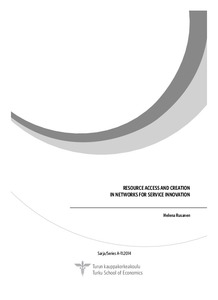Resource access and creation in networks for service innovation
Rusanen Helena
https://urn.fi/URN:NBN:fi-fe2021042714813
Tiivistelmä
Current research highlights the role of resources in service innovation success
and the role of networks in providing resources for innovation. However,
research on resources in service innovation is very limited and a clear deficit
also exists in research applying a network perspective for service innovation.
This study is the first one to focus on resource access and creation in networks
for service innovation.
The objective of this study is to explore interaction for resources in
networks over the service innovation process. This is accomplished by
analyzing resource access and creation in business-to-business service
innovation. The research aims to shed light on resources provided by networks
for service innovation, and on relationships and activities to access those
resources and to create new resources. The Interaction and Network Approach
provides the theoretical background to the study.
This study focuses on the empirical part on business-to-business service
innovations in the technical/engineering field. Qualitative multi-case study
research with embedded cases enabled investigation on interaction for
resources within a real-life context. The empirical research was conducted in
three case companies and five service innovation projects in networks, and the
main data consisted of 57 in-depth interviews. Processes of the innovation
projects were studied longitudinally both in real time and retrospectively. An
abductive approach enabled exploration on a phenomenon that has not
previously been studied and the building of theory in forms of theoretical
models, frameworks, and typologies.
This study found that a variety of resources are accessed from networks for
service innovation. These resources were divided into individual and
organizational resources depending whether they are bound to individuals or
organizations. Resources that networks provide for service innovation could
be further categorized into human, procedural, technological, financial,
facility, relational, and informational resources. This study also shows that
different resource categories play different roles in service innovation.
Different kinds of resource can be accessed through four separate access
strategies and types of relationship. This research further found that resource
integration is a resource access strategy for human and procedural resources, which is employed in the creation of new resources in service innovation.
Different types of service call for integrating complementary, supplementary
or heterogeneous human resources.
The main contribution of this research is in advancing understanding on
interaction for resources in service innovation. It provides new understanding
on service innovation resources. The study resulted in a theoretical model on
resource access in service innovation and a model for resource integration in
service innovation.
Kokoelmat
- Rinnakkaistallenteet [27094]
